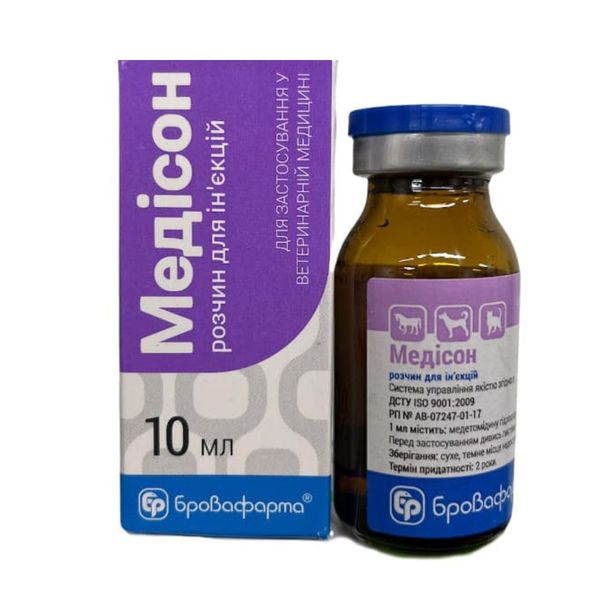|
Quantity
|
Out of stock
|
||
|
|
|||
Madison
0.1% solution for injections
Storage
1 ml of the drug contains:
medetomidine hydrochloride - 1 mg
Description
The liquid is colorless, transparent.
Pharmacological properties
Medetomidine is a highly selective, broad-spectrum alpha-2 adrenoceptor antagonist. Has a strong central and peripheral sympatholytic effect - reduces the release of norepinephrine from the endings of sympathetic nerves. The sedative effect is due to the inhibition of the excitation of the blue spot, the main noradrenergic nucleus in the brain stem. Acting on this area, medetomidine exhibits a sedative effect, the strength of which depends on the dose: small doses give a moderate sedative effect without analgesia, large ones - a pronounced sedative effect with analgesia.
Medetomidine causes typical hemodynamic changes mediated by alpha-2 adrenoceptors, such as bradycardia and arterial hypotension or hypertension. In small doses, it reduces heart rate and blood pressure, and in large doses, it has a vasoconstrictive effect. In the case of slow infusion, it reduces heart rate and blood pressure, and in the case of rapid administration, it activates extrasynaptic alpha-2 adrenoceptors of peripheral vessels, as a result of which peripheral vasoconstrictor effects prevail, and bradycardia becomes more pronounced.
After intramuscular administration, it is quickly absorbed and distributed in the body, the maximum concentration in the blood is reached in 15-30 minutes. 85-90% of medetomidine binds to blood plasma proteins. It is oxidized in the liver, a small part is methylated in the kidneys. Most of the metabolites are excreted in the urine. The half-life is 1-2 hours.
Indication
The drug is used:
• for dogs — for sedation and analgesia during examination, diagnostic, preventive and therapeutic manipulations, for premedication before general narcotics, general anesthesia with propolis or ketamine, as a sedative and analgesic agent (in combination with butorphanol);
• for cats — for sedation, induction of general anesthesia during surgical interventions (in combination with ketamine), sedation and analgesia (in combination with butorphanol), general anesthesia (in combination with butorphanol and ketamine);
• sports horses — for sedation and analgesia during examination, small surgical interventions and diagnostic manipulations, premedication in the case of injection or inhalation of a narcotic drug.
Contraindication
Do not prescribe to animals with increased sensitivity to the active substances of the drug, diseases of the cardiovascular and respiratory systems, impaired liver and kidney functions, animals in a state of shock, pregnant, exhausted and weakened animals.
Do not use together with amines that have a sympathomimetic effect and anticholinergic drugs.
Do not prescribe to puppies up to 12 weeks and productive animals.
Method of application and dosage
The drug is administered intravenously, intramuscularly, or subcutaneously to dogs, intramuscularly or subcutaneously to cats, and intravenously to horses. The effect is faster after intravenous administration. To continue the sedative and analgesic effect, the drug can be re-injected 10-15 minutes after the first injection.
Dosages of the drug for different types are given in the table.
Kind of animals
Method of administration
Purpose of application
Drug dose, ml/10 kg of body weight
Dogs
in/in, in/m, p/k
light sedation
medium and deep sedation
premedication
0.1–0.3
0.3–0.8
0.1–0.2
cats
in/m, p/k
moderate sedation
deep sedation
premedication
0.4–0.8
0.8–1
0.1–0.3
A horse
in/in
light sedation
medium and deep sedation
0.2–0.4
0.4–0.8
The dose of the drug is chosen depending on the required effect, individual characteristics and breed of the animal. For small breed dogs, the dose should be higher than for large dogs.
The maximum effect is achieved after 10-15 minutes, the effect of the drug lasts 0.5-1.5 hours, if necessary, the drug can be administered again to extend the time of action.
12 hours before anesthesia, it is recommended to put the animal on a fasting diet.
For premodification, the drug is administered intravenously in 10 minutes, intramuscularly in 20 minutes. The drug should be administered slowly over 30-45 seconds.
An overdose of the drug leads to delayed awakening of the animal after anesthesia or sedation.
To eliminate cardio-respiratory effects and overdose, the introduction of alpha-2 antagonists (atipamezole, antisedan) is recommended.
In case of slow awakening, symptomatic therapy is carried out.
Reservation
After the introduction of the drug, the heart rate may decrease and blockade or bradypnea with a temporary phase may occur. The rate of breathing may also decrease and cardiac arrest may occur. In case of suppression of blood circulation and breathing, lung ventilation and oxygenation should be carried out.
Immediately after administration, a decrease in blood pressure is possible, then it is restored to almost normal values. Pressure can also decrease when using the drug in large doses and in the case of rapid administration.
The drug can cause vomiting, especially in cats, a few minutes after administration
and after waking up from the narcotic tract.
In some cases, hyperglycemia may develop due to suppression of insulin secretion, and sometimes pulmonary edema.
After 1.5-2 hours after using the drug, urination is recorded. Muscle tremors and increased sensitivity to loud sounds can be observed.
In dogs with a body weight of less than 10 kg, side effects occur more often. Horses may experience rapid arrhythmia, impaired coordination of movements, and increased sweating after administration of the drug. Sometimes there is a slight tremor of individual muscles or muscle groups and uncontrolled urination. Blood pressure initially rises slightly, but later returns to normal.
Before administering the drug, a clinical examination of animals should be carried out and the drug should be carefully prescribed in case of diseases of the liver, kidneys, cardiovascular system, unsatisfactory general condition, as well as to young and old animals.
Before using the drug and for 12 hours after the end of the manipulations, the animal must be kept in a warm, quiet place. Procedures are carried out 10-30 minutes after administration and only after sedation has occurred.
When used with other sedatives or analgesics (thiopental, halothane, propofol, etc.), their dose is reduced by 50-90%.
After using the drug, animals cannot be fed and watered until the swallowing reflexes are completely restored.
Rubber gloves should be used when working with the drug. If the drug gets on the skin, it should be washed immediately with running water.
If you have accidentally injected yourself with the drug, contact your doctor immediately (do not get behind the wheel of a car!) and show him the package insert for the drug.
Packaging
Glass bottles of 10, 20 ml (1 pc. in a cardboard box).
Storage conditions
In a dry, dark, inaccessible place for children at temperatures from +8 to +25 °C.
After opening the bottle, store the drug in the refrigerator and use within 30 days.
Expiration date
2 years.
































